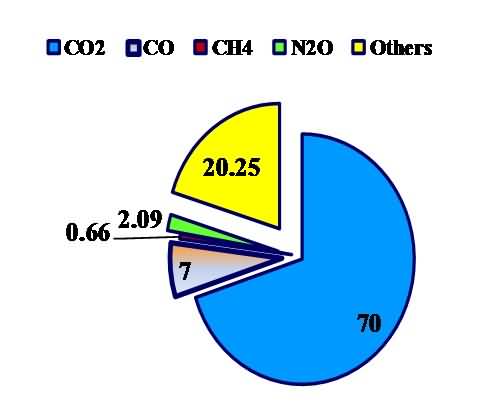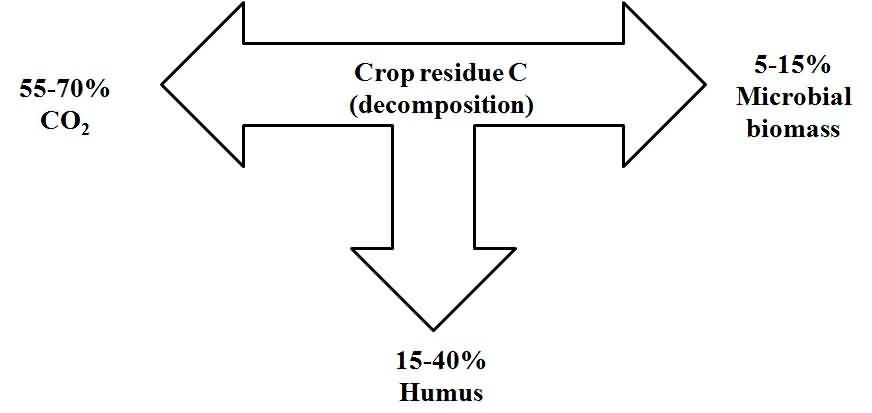मिट्टी में पोषक तत्वों की उपलब्धता में वृद्धि के लिए फसल अवशेषाेें का रखरखाव
Crop residues have multiple uses on agricultural and allied sectors. Rice-wheat is the founder cropping system of Indo-Gangetic Plains (IGP) of South Asia which support food and energy source of a millions. Burning and/or removal of crop residue are not economical rather than endanger to ecosystem functions.
A multiple problems are faced by crop growers on managing residues at time of harvesting to proceed for next crop. However, by adopting some useful interventions, a sizeable quantity of primary plant nutrients can be supplemented in soil without sacrificing the economic return of targeted crop.
Crop residues are organic vegetative crop materials offer sustainable and ecologically sound alternatives for meeting the nutrient requirements of crops. These resources are facing increasingly competing uses, including soil and water conservation, livestock feed, industrial uses (e.g. papermaking fiber) and most recently, as feed stocks for cellulosic ethanol production (Blanco-Canqui et al., 2009).
Rice-wheat is a major crop rotation in the Indo Gangetic Plains (IGP) of South Asia, spread over 13.5 million ha in Bangladesh, India, Nepal and Pakistan (Ladha et al., 2000). Burning of rice residues is cost-effective and the predominant method of disposal in areas under combined harvesting in the IGP (Samra et al., 2003).
However, disposal of crop residues by burning is often criticized for accelerating losses of soil organic matter (SOM) and nutrients, increasing C emissions, causing intense air pollution, and reducing soil microbial activity (Kumar and Goh, 2000). The gaseous emissions from burning of rice straw are 70.0, 7.0, 0.7, 2.09 and 20.25% of CO2, CO, CH4, N2O and others (Fig 1) (Samra et al., 2003).
Oppositely, decomposition of crop residues releases about 55-70% of the C to the atmosphere as CO2, 5-15% is incorporated into microbial biomass, and the remaining C (15-40%) is partially stabilized in soil as new humus (Fig 2) (Stott and Martin, 1989).


Fig.1 Fig.2
Problem for incorporation of crop residues
Crop residues have been incorporated immediately before planting the next crop, grain yields were lower than where residues are removed or burned, resulting in N immobilization, a problem that is attributable to the slow rates of residue decay.
In rice-wheat cropping systems, too, management of rice straw, rather than wheat straw, is a serious problem, because there is very little turn-around time between rice harvest and wheat sowing. Other potential problems of residue incorporation just before rice transplanting include accumulation of phenolic acids in soil and increased CH4 emission under flooded conditions (Grace et al., 2003).
In this case, the timing of incorporation of crop residues is more important than the amount.
Compared with the traditional method of wet incorporation shortly before planting of the next rice crop, the potential benefits of shallow incorporation shortly after crop harvest include accelerated aerobic decomposition of crop residues (about 50% of the C within 30-40 d), leading to increase N availability, and reduced CH4 emissions.
Early incorporation also allows additional time for phenol degradation to occur under aerobic conditions, thereby avoiding any adverse effect on germinating seeds and seedlings.
Management aspect of crop residues for better cultivation
Time of incorporation had a large effect on the decomposition of rice residue during the fallow phase. Differences in decomposition rates of crop residues were positively correlated with crop N content. It is generally accepted that residues with low N content or a high C:N ratio decompose more slowly than those with a low C:N ratio or high N content.
However, De Haan (1977) found no relationship between percentage of N in added plant residue and the rate of decomposition. The rate of plant residue breakdown depends on the relative proportion of biochemical composition such as lignin, hemicellulose and polyphenol. Many workers have found that increasing lignin concentration reduces the decomposition rate and nutrient release from plant residues.
Yadvinder-Singh et al. (2004) reported that at wheat seeding, the mass loss of rice residue was 51% for a 40-day decomposition period, compared with 35% for a 20-day decomposition treatment and 25% for a 10-day decomposition treatment. The amount of mass loss remained significantly higher for the 40-day decomposition period compared to the 10-day or 20-day period up to 72 days after seeding of wheat. At the end of the study, no significant difference, however, was noted among the three treatments.
Yadvinder-Singh et al. (2004) also noted that substantial immobilization of fertilizer N with incorporation at 10 days after fertilizer application in treatments in which rice straw incorporation at 10 days after fertilizer application in treatments in which rice straw was incorporated at 0 and 10 days before application of fertilizer compared to the no-straw treatment.
The magnitude of immobilized N was influenced by the decomposition period of rice straw prior to fertilizer application. Interestingly, immobilization of N in the treatment where fertilizer N was applied concurrently with straw incorporation (0 day) always remained lower than the treatment without straw.
These data clearly demonstrated that incorporation of rice straw at 20 d or more before wheat sowing will minimize any adverse effects on crop growth due to N immobilization after straw incorporation.
The results from the decomposition and N mineralization studies suggested that rice residue is likely to have little adverse effects on N availability in the soil when it is allowed to decompose under aerobic conditions for at least 10 days before sowing of the next upland crop.
The rice and wheat productivity is not adversely affected when rice residue is incorporated for at least 10 d and preferably 20 d before the establishment of the succeeding crop.
In other studies, application of rice and wheat straw (with C:P ratio >300) caused immobilization of P during the first 15 days and then progressively increased the available P content in soil from the 30th day onward (Mukherjee et al., 1995). Mishra et al. (2001) reported that during the decomposition of rice straw, P content increased from 0.10 to 0.195% with time.
About 22.5 and 59.4%, of the total P present in rice straw was released within 5 and 23 weeks, respectively, after its incorporation into the soil. Verma and Mathur (1990) found that incorporation of rice straw along with cellulolytic microorganisms and rock phosphate at 15 days before wheat sowing resulted in a significant increase in wheat yield over recommended fertilizer management practices.
Potassium is not bound in any organic compound in the plant material, and thus its release does not involve microorganisms. Rice straw contains about 65% of total K in water-soluble form and it is readily released in the soil upon incorporation.
Release of K from rice straw occurred at a faster rate, and within 10 days after incorporation. Available soil K contents increased from 50 mg K kg-1 in the untreated control to 66 mg K kg-1 in straw-amended treatments.
Conclusion
Crop residues are not a waste. Because of serious environmental effects, crop residue burning is not desirable. Rice residue is likely to have little adverse effects on N availability in the soil when it is allowed to decompose under aerobic conditions for at least 10 days before sowing of the next upland crop.
But, rice and wheat productivity is not adversely affected when rice residue is incorporated for at least 10 d and preferably 20 d before the establishment of the succeeding crop.
Available P content in the soil increases after 30 days of incorporation of straw into the soil. Release of K from the rice straw occurs quickly after incorporation into the soil.
- References
- Blanco-Canqui, H., Stephenson, R.I., Nelson, N.O. and Presley D.R. (2009). Journal of Environmental Quality 38, 2365-2372.
- Ladha, lK., Fischer, K.S., Hossain, M., Hobbs, P.R. and B. Hardy. (2000). Improving the productivity and sustainability of rice-wheat of the Indo-Gangetic Plains: A synthesis of NARS IRRI partnership research. p. 1-31. IRRI Discussion Paper Sereminer 40. IRRI, Manila, Philippines.
- Samra, J.S., Bijay-Singh and K. Kumar. 2003. Managing Crop Residues in the Rice-Wheat System of the Indo-Gangetic Plain. p.173-195. In J.K. Ladha et al. (ed.) Improving the productivity and sustainability of rice-wheat systems: Issues and impact. American Society of Agronomy Special Management 13, 111-116.
- Kumar, K. and Goh, K. M. (2000). Crop residues and management practices: Effects on soil quality, soil nitrogen dynamics, crop yields, and nitrogen recovery. Advance in Agronomy 68, 197- 319.
- Stott, D. E. and Martin, J. P. (1989). Organic matter decomposition and retention in arid soils. Arid Soil Research Rehabilitation 3, 115-148.
- Grace, P.R., Jain, M.C., Harrington, L. and Robertson, G.P. (2003). Long-term sustainability of the tropical and subtropical rice-wheat system: An environmental perspective. p. 27-43. In ln. Ladha et al. (ed.) Improving the productivity and sustainability of rice-wheat systems: Issues and impact. American Society of Agronomy Special Publication 65, Madison, WI.
- De Haan, S. (1977). Humus, its formation, its relation with the mineral part of the soil and its significance for soil productivity. In "Soil Organic Matter Studies", Volume I, pp. 21-30. IAEA/FAO, Vienna.
- Yadvinder-Singh, Malhi, S. S., Nyborg, M. and Beauchamp, E. G. (1994b). Large granules, nests or bands: Method of increasing efficiency of fall applied urea for small grains in North America. Fertilizer Research 38, 61-87.
- Mukherjee, D., Chattopadhyay, M. K. and Chakravarty, A. (1995). Some aspects of chemical changes as influenced by diVerent organic additives in Entisol of Gangetic origin. Advance in Plant Science 8, 169-176.
- Mishra, B., Sharma, P. K. and Bronson, K. F. (2001). Decomposition of rice straw and mineralization of carbon, nitrogen, phosphorus and potassium in wheat field soil in western Uttar Pradesh. Journal Indian Society Soil Science 49, 419-424.
- Verma, S. and Mathur, R. S. (1990). The eVects of microbial innoculation on the yield of wheat when grown in straw-amended soil. Biological Wastes 33, 9-16.
Authors:
Nirmalendu Basaka*, Ashim Dattaa, Tarik Mitranb, Bholanath Sahac
aDivision of Soil & Crop Management, ICAR-Central Soil Salinity Research Institute, Karnal 132 001, Haryana, India;
bSoil and Land Resources Assessment Division, Land Resources, Land use Mapping and Monitoring Group, National Remote Sensing Centre, Hyderabad, India;
cCollege of Horticulture, Bihar Agricultural University, Noorsarai, Nalanda, Bihar – 803 113;
*author’s e-mail:
